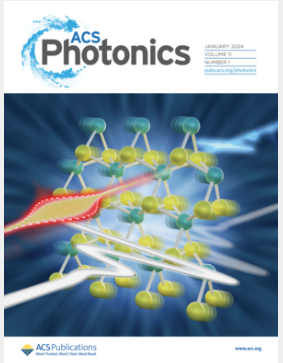高能效热光学移相器的超低损耗设计方法
IF 6.7
1区 物理与天体物理
Q1 MATERIALS SCIENCE, MULTIDISCIPLINARY
引用次数: 0
摘要
热光移相器由于其简单的设计和完善的制造工艺,是大规模光子集成电路中广泛应用的关键元件。在低功耗热光移相器中,对插入损耗可忽略不计的要求变得越来越重要,特别是在激光雷达、光子计算、可编程光子学和量子光子学等应用中采用的级联配置。为了解决这一需求,我们提出了一个基于基本耦合模式理论的综合理论。我们在紧凑的螺旋波导中采用相位失配来消除耦合损耗,提高热光移相器的效率。我们的方法成功地克服了固有的权衡,展示了在c波段工作的紧凑和节能的硅基移相器的超低插入损耗。所提出的设计最简单的器件在所有残余吸热型移相器中显示出最低的测量插入损耗0.14 dB。同时,测量到的功耗和调制带宽分别为3.4 mW/π和12.5 kHz。这种方法对于最小化各种残余热吸收型热光移相器的插入损耗具有很大的希望,这些移相器采用不同的材料并在不同的波段(如电信光谱和可见光谱)中工作。c波段硅移相器在IMEC的Si/SiN平台上的实验实现表明,它有潜力成为广泛光子电路架构中可扩展大规模生产的基本组件。本文章由计算机程序翻译,如有差异,请以英文原文为准。

Ultralow Loss Design Methodology for Energy-Efficient Thermo-Optic Phase Shifters
Thermo-optic phase shifters are crucial components extensively utilized in large-scale photonic integrated circuits due to their simple design and well-established fabrication processes. The requirement for negligible insertion loss in low-power-consumption thermo-optic phase shifters is becoming increasingly critical, particularly in cascaded configurations employed in applications such as LiDAR, photonic computing, programmable photonics, and quantum photonics. To address this need, we present a comprehensive theory based on the fundamental coupled-mode theory for sharp-bent waveguides. We employ phase mismatch in a compact spiral waveguide to eliminate coupling loss and enhance the efficiency of thermo-optic phase shifters. Our approach successfully overcomes inherent trade-offs, demonstrating ultralow insertion loss in compact and power-efficient silicon-based phase shifters operating in the C-band. The proposed simplest-design device exhibits a record lowest measured insertion loss of 0.14 dB among all residual-heat-absorption-type phase shifters. Simultaneously, the power consumption and modulation bandwidth are measured to be 3.4 mW/π and 12.5 kHz, respectively. This methodology holds substantial promise for minimizing the insertion loss across various residual-heat-absorption-type thermo-optic phase shifters, which employ different materials and operate in diverse bands, such as the telecom and visible spectra. The experimental realization of the C-band silicon phase shifter on IMEC’s Si/SiN platform expresses its potential as a fundamental component for scalable mass production in extensive photonic circuit architectures.
求助全文
通过发布文献求助,成功后即可免费获取论文全文。
去求助
来源期刊

ACS Photonics
NANOSCIENCE & NANOTECHNOLOGY-MATERIALS SCIENCE, MULTIDISCIPLINARY
CiteScore
11.90
自引率
5.70%
发文量
438
审稿时长
2.3 months
期刊介绍:
Published as soon as accepted and summarized in monthly issues, ACS Photonics will publish Research Articles, Letters, Perspectives, and Reviews, to encompass the full scope of published research in this field.
 求助内容:
求助内容: 应助结果提醒方式:
应助结果提醒方式:


